(This article was written by capito translated into easy language.)
The Essl Foundation is an organization dedicated to ensuring that people with disabilities can participate in society and have the same rights as people without disabilities. This applies to all areas of life, especially the arts.
15 percent of people have a disability. That's 1.3 billion people worldwide. They are excluded from many things,
which are completely normal for people without disabilities. But it shouldn't be like that. The United Nations, for example, has agreed on this. The United Nations is an organization to which almost every country in the world belongs. They have set 17 goals. The goals are to be achieved by 2030 and to improve the lives of everyone. All countries have signed the goals. These goals state, for example, that no one should be left behind. The United Nations has also made a treaty: the UN Convention on the Rights of Persons with Disabilities. Many countries have signed the treaty, including Austria. They must abide by the treaty.
The contract states:
People with disabilities must be able to participate in society. They must have the same rights as people without disabilities. But even though the goals and the treaty exist, this is not yet reality. People with disabilities are still disadvantaged. They cannot participate in everything, for example, when it comes to art.
For a world without barriers
Martin Essl, Gerda Essl, and their four children founded the Essl Foundation in 2007. The organization supports social projects and new ideas.
Especially when it comes to people with disabilities. The Zero Project has been in existence since 2010. This is a project of the Essl Foundation. With this project, the Essl Foundation aims to help people with disabilities with new ideas
really get their rights.
It is very important to the Essl Foundation that everyone has access to art. This is because the Essl family themselves are very fond of art. Therefore, the Essl Foundation supports new ideas for how everyone can experience art. The Essl Foundation wants to show artists that a work of art is even better when it can be experienced with multiple senses.
Here you can see 3 examples of such works of art.
The plaque on human dignity
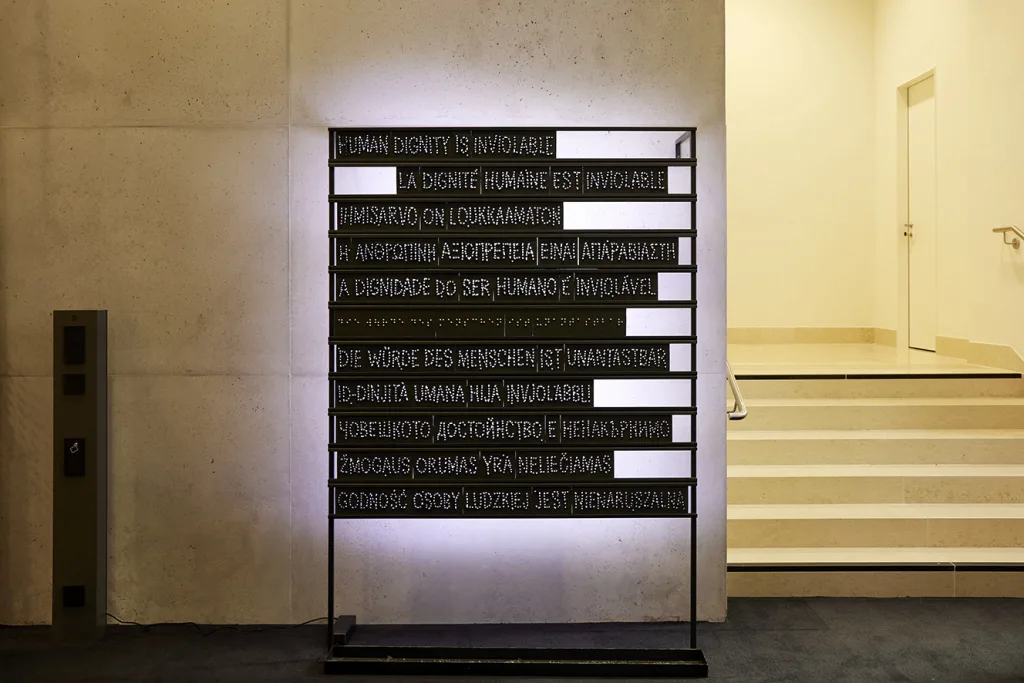
This is a work of art by Wilfried Gerstel. It is about fundamental rights,
that all people in Europe have. The European Union has written down these fundamental rights. One sentence in the fundamental rights states: Human dignity is inviolable. This means: No one may violate the dignity of another. No one may be treated worse. Every person is of equal value.
For the artwork, Wilfried Gerstel selected 10 languages spoken in Europe. This demonstrates that Europe is home to many different languages and scripts. Wilfried Gerstel wrote the sentence in the 10 languages on panels. The artwork also includes a Braille line. This allows blind people and people with visual impairments to read the sentence.
The artwork belongs to Martin and Gerda Essl. They have loaned it to the Austrian Parliament. The Parliament building was recently
It was very important that the building be barrier-free and that everyone could use it easily. Therefore, the artwork fits perfectly into the new parliament building.
The Corona Memorial
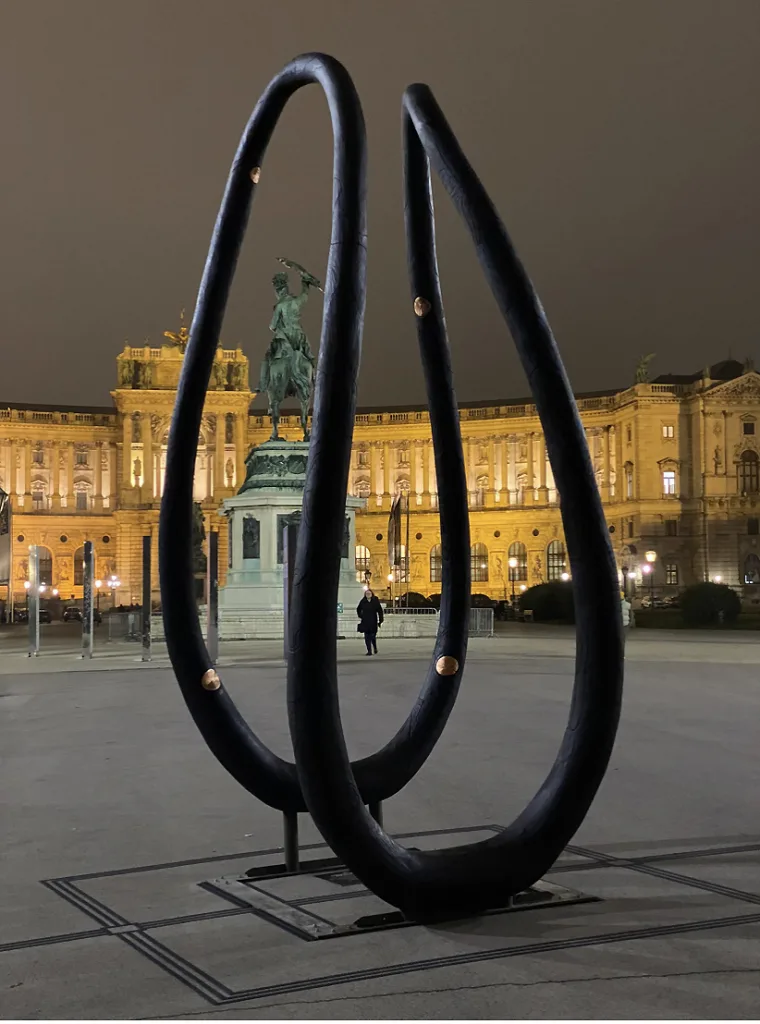
The Corona Memorial is a work of art by Emmerich Weissenberger and Nora Ruzsics. They collaborated with Alfred Strigl of the ÖIN research institute. The wooden memorial consists of two black ribbons.
They go up and down endlessly. The 2 loops represent
- Sustainability:
This means that we take good care of the environment. - Inclusion:
This means that all people
can participate in society.
These two things are very important for our lives after the coronavirus pandemic. If we want a good future, we must take good care of the environment and all people. The memorial is barrier-free. Everyone can walk through it or drive through with a stroller, wheelchair, or walker. The space between the loops represents love.
A love that applies to all people and all things.
The statue features seven bronze circles. The circles represent seven important qualities we need for a bright future, such as courage and hope. The memorial is primarily dedicated to these people:
- People who died because of Corona.
- People who because of Corona
had a difficult life. - People who contribute to society
helped during Corona.
For example, doctors.
In 2022, the monument stood on Heldenplatz in Vienna.
In 2023, Martin and Gerda Essl donated the monument to the Medical University of Vienna. Initially, it will be located in front of a hospital, the Vienna General Hospital, where it can be viewed. Later, it will be located in the Medical University.
The second monument
There is a second monument that looks the same as the Corona monument.
It is made of golden bronze and is called Monument of Hope. This is English and means monument of hope.
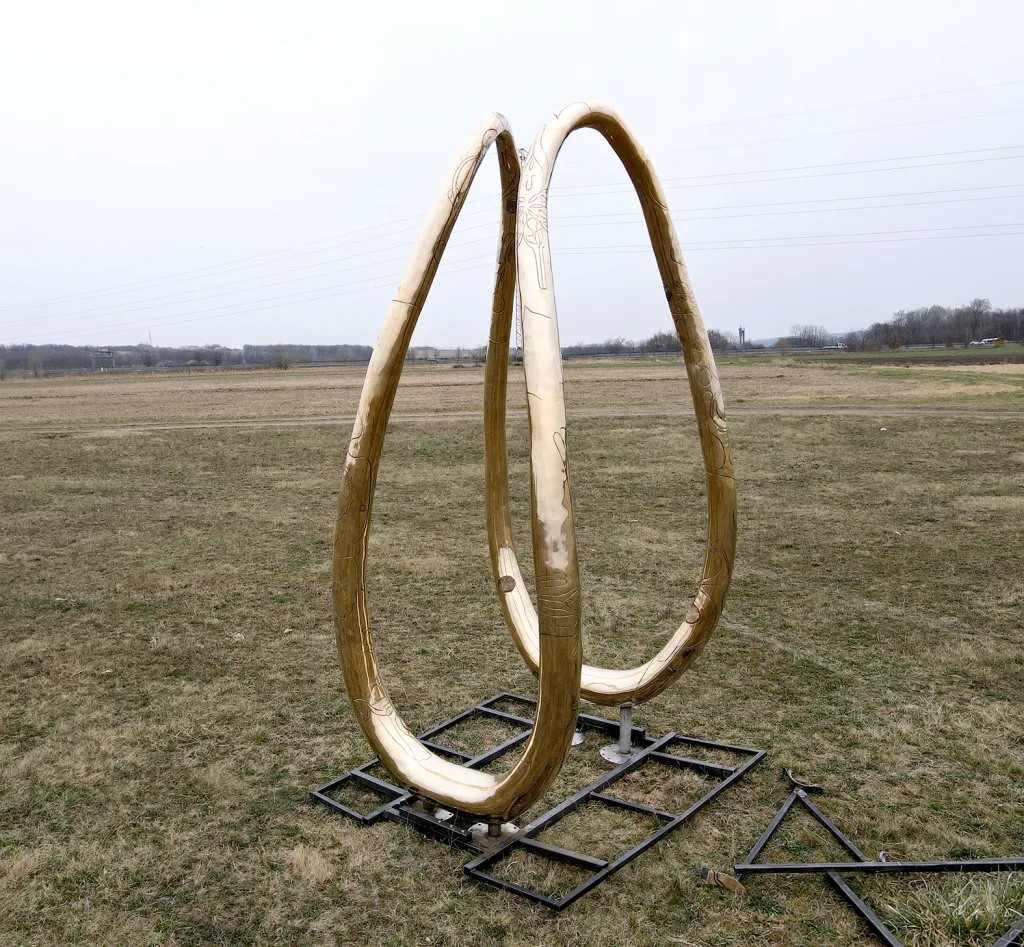
The Monument of Hope is to be brought to many countries around the world.
It's meant to demonstrate that we can have a bright future after the coronavirus pandemic and include everyone. To make this possible, a sled was specially built. The sled can be used to push the monument into a container.
This way the monument can be moved to different locations.
If the memorial was everywhere, the container might be converted into a small museum. The museum should be easily accessible to everyone.
It is intended to show how art can include all people.
Street art for everyone
Street art is English. It refers to public art, for example, on buildings and in the streets.
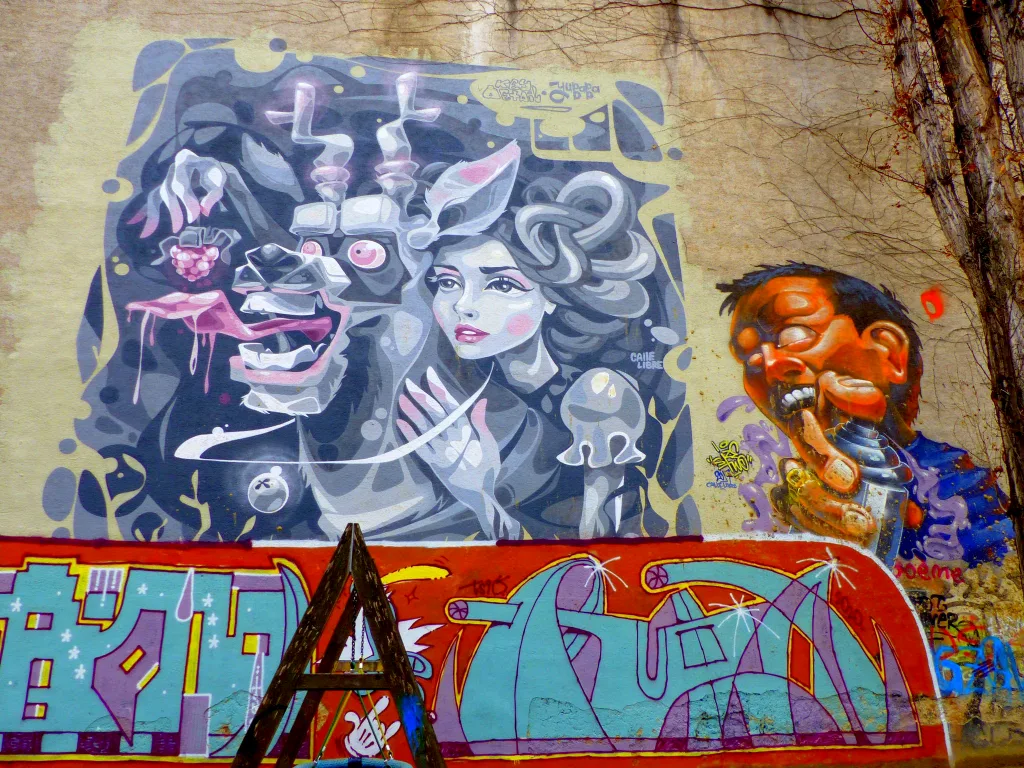
In Serbia, there is an organization called Street Art Belgrade. Belgrade is the capital of Serbia. Street Art Belgrade researches and promotes public art in Serbia. The organization has been around for 20 years. It is especially important to Street Art Belgrade that everyone can experience the art.
A few years ago, three murals were created in Vienna. These are the first murals in Austria to be made accessible to everyone. Street Art Belgrade selected the images together with Jakob Kattner.
He's leading a major street art event in Vienna called Calle Libre.
This is Spanish and means free road.
The murals for all people are located at Karl-Farkas-Platz. This is a square in Vienna's 7th district. There's also a park there. At the entrance to the park, there will soon be a tactile model for each mural. A tactile model is a small model that looks exactly like the artwork. Blind people can touch it and thus experience the artwork. A Braille description is provided below the tactile model.
There is also a board with information for people,
who can see. And there's a QR code. If you scan it, you get more information about the artwork.
Wall picture Inclusion
Every year, the Zero Project organizes a large gathering for people with and without disabilities from all over the world. In 2023, this gathering will also include the creation of a mural in collaboration with Street Art Belgrade.
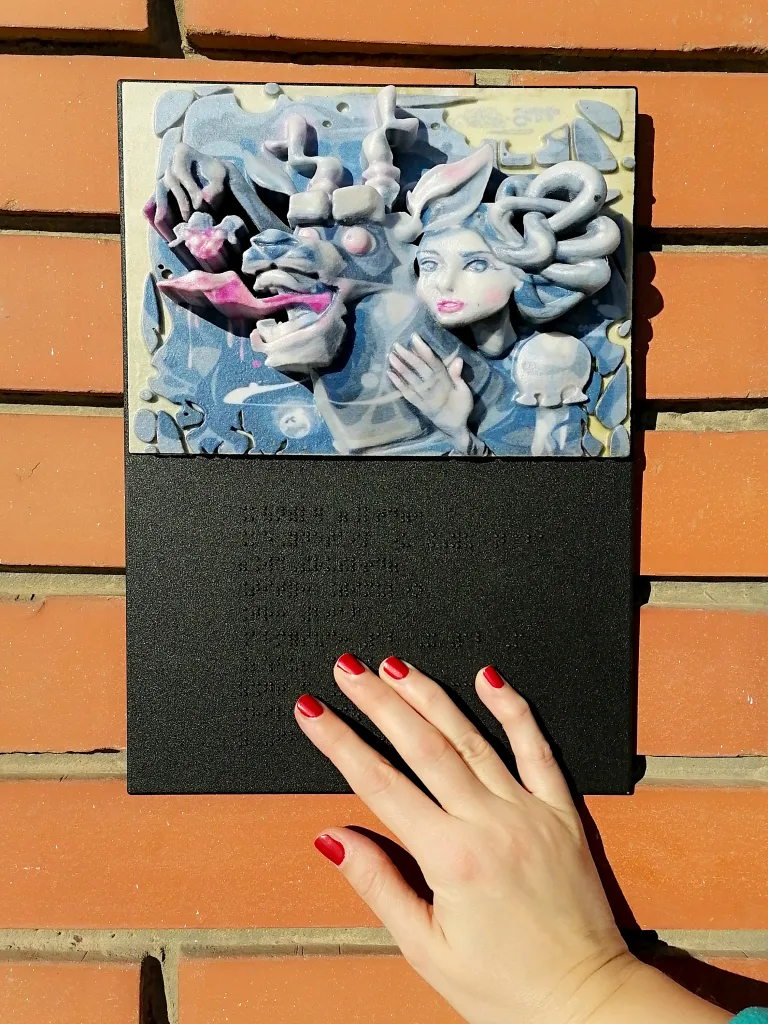
Everyone can then perceive and experience the mural.
It will be exhibited in Vienna at the House of Philanthropy. The mural is intended to demonstrate what art can look like for everyone.
Interview with Martin Essl
Martin Essl is an entrepreneur himself and has seen that there are many advantages
when people with disabilities work in the company.
Martin Essl wants to demonstrate this to other companies. That's why he launched the Zero Project. With the Zero Project, he is committed to ensuring that people with disabilities can fully participate in society.
The museum guide had a conversation with him.
Museum Guide:
Why do we need art that everyone can perceive and experience?
Martin Essl:
Because everyone has the right to art. Austria signed the UN Convention on the Rights of Persons with Disabilities in 2008.
This means that Austria must adhere to it.
The UN Convention states: It must be possible for all people to participate fully in society. This naturally includes museums. Because museums are important in society. Moreover, many museums receive
also receive money from the Austrian government. The UN Convention therefore also applies to them.
Museum Guide:
What does an inclusive museum look like to you?
Martin Essl:
When art is available to everyone, everyone can experience it together. The museum then becomes a place where people with and without disabilities meet. Through art, we also learn to see things differently.
All people should have the opportunity to experience art.
But they shouldn't be forced to do so. Inclusive art should be available to everyone, regardless of whether they have a disability or not.
Museum Guide:
Does this mean that inclusive art is also good for people without disabilities?
Martin Essl:
Yes. We all want to experience things with as many senses as possible. This way, we remember them much longer. So it's good for everyone to
when they can experience art with multiple senses.
You can see this, for example, in statues that are completely smooth in places. Many people like to touch statues. Another example is music. You can not only hear the rhythm of the music, but also feel it. That's good for deaf people. But it's also exciting for people who can hear.
Museum Guide:
There have been incidents in museums recently. Young people campaigning for climate change have come to museums and dirtyed works of art. Are museums now afraid that the works of art will be damaged if people attack them?
Martin Essl:
Of course, works of art must be protected. But there are many ways to make them accessible to everyone. There are also technical possibilities,
that help with this.
Not all works of art need to be accessible to everyone. Some works of art are enough. No one can remember all the works of art anyway.
when he has visited a museum. Therefore, it's okay if not all works of art are accessible to everyone.
Museum Guide:
Is it possible to make all art accessible to everyone?
Martin Essl:
At the Zero Project, we are always looking for new ideas on how to do this.
We've already collected many examples. They show that there are already many possibilities today. This way, museums can see what's possible. And people with disabilities can see what new ideas and developments are available.
Explanation: Zero Project
Zero Project is English and means zero project. It is pronounced like this: Siro Protschek. The name is intended to convey that the organization works for a society in which there are no barriers for people with disabilities.
Zero Project works to ensure the implementation of the UN Convention on the Rights of Persons with Disabilities. The following topics are particularly important in the UN Convention:
- Accessibility
- Work
- Education
- Self-determined life
- Have a say in politics
Every year, Zero Project seeks new ideas on these topics. These often focus on information technology, but also on art. Each year, 500 new ideas are submitted from more than 100 countries. The organization collaborates with experts around the world. More than 1,000 experts select the best ideas each year. These best ideas are presented at the Zero Project Conference. This is the major meeting that Zero Project organizes every year. It takes place at the United Nations Headquarters in Vienna. More information can be found here:
zeroproject.org